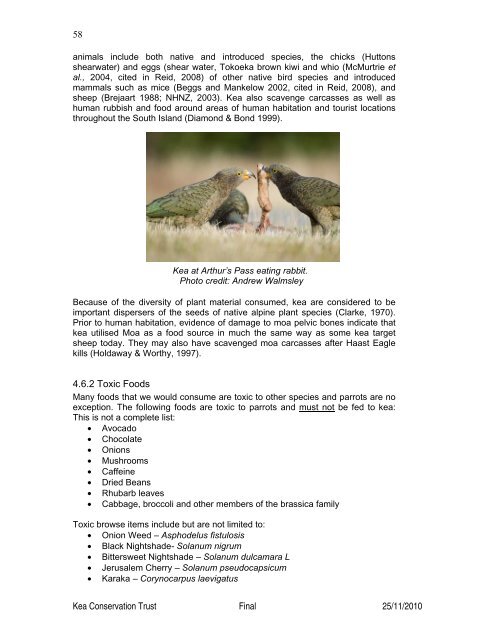(Nestor notabilis) Husbandry Manual - Kea Conservation Trust
(Nestor notabilis) Husbandry Manual - Kea Conservation Trust
(Nestor notabilis) Husbandry Manual - Kea Conservation Trust
Create successful ePaper yourself
Turn your PDF publications into a flip-book with our unique Google optimized e-Paper software.
58<br />
animals include both native and introduced species, the chicks (Huttons<br />
shearwater) and eggs (shear water, Tokoeka brown kiwi and whio (McMurtrie et<br />
al., 2004, cited in Reid, 2008) of other native bird species and introduced<br />
mammals such as mice (Beggs and Mankelow 2002, cited in Reid, 2008), and<br />
sheep (Brejaart 1988; NHNZ, 2003). <strong>Kea</strong> also scavenge carcasses as well as<br />
human rubbish and food around areas of human habitation and tourist locations<br />
throughout the South Island (Diamond & Bond 1999).<br />
<strong>Kea</strong> at Arthur’s Pass eating rabbit.<br />
Photo credit: Andrew Walmsley<br />
Because of the diversity of plant material consumed, kea are considered to be<br />
important dispersers of the seeds of native alpine plant species (Clarke, 1970).<br />
Prior to human habitation, evidence of damage to moa pelvic bones indicate that<br />
kea utilised Moa as a food source in much the same way as some kea target<br />
sheep today. They may also have scavenged moa carcasses after Haast Eagle<br />
kills (Holdaway & Worthy, 1997).<br />
4.6.2 Toxic Foods<br />
Many foods that we would consume are toxic to other species and parrots are no<br />
exception. The following foods are toxic to parrots and must not be fed to kea:<br />
This is not a complete list:<br />
• Avocado<br />
• Chocolate<br />
• Onions<br />
• Mushrooms<br />
• Caffeine<br />
• Dried Beans<br />
• Rhubarb leaves<br />
• Cabbage, broccoli and other members of the brassica family<br />
Toxic browse items include but are not limited to:<br />
• Onion Weed – Asphodelus fistulosis<br />
• Black Nightshade- Solanum nigrum<br />
• Bittersweet Nightshade – Solanum dulcamara L<br />
• Jerusalem Cherry – Solanum pseudocapsicum<br />
• Karaka – Corynocarpus laevigatus<br />
<strong>Kea</strong> <strong>Conservation</strong> <strong>Trust</strong> Final 25/11/2010












